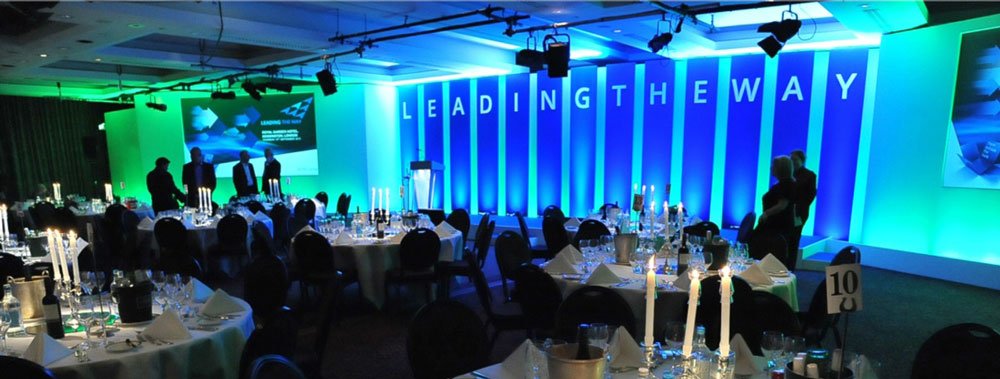The Secrets to a Successful Conference Presentation


…And it’s going to take a whole lot more than just a set of great PowerPoint slides. To get the attention of our increasingly restless audiences – and then to keep it – requires some forward planning but fortunately there is an array of tools available to us and, as Holly Faulkner points out, it’s time to get creative.
Even after all my years working in our London design agency and listening to almost every kind of keynote presentation you can imagine, my admiration for those who get up to address a room full of people has never waned. No matter how experienced you are, it takes courage to make yourself the centre of attention in front of dozens or hundreds of attendees, with so many eyes and minds waiting to be educated and entertained.
Despite an over reliance on static PowerPoint slides in many industries, a growing number of businesses are changing the expectations of what conference presentations should be today. As a specialist PowerPoint design agency, we are being asked more and more to create conference presentations that provide added interactivity and alternative methods of message delivery. Of course, content, story and presentation style still remain at the heart of any good presentation but the possibilities available with modern technology offer more than ever before.
Video content at conferences
Video is rapidly becoming king when it comes to content, allowing businesses to present core brand messages quickly and effectively without losing the interest of the viewer. One of the most surprising things we continue to notice is how few conference presentations actually utilise it effectively. While that trend is slowly changing, there is still a higher proportion of those that do not contain video content compared to those that do feature it.
With literally billions of hours of videos available on sites like YouTube or Daily Motion, finding the right clips should not prove difficult. Presentation designers will find they can easily slot into a presentation and prove to be an extremely effective way of engaging the audience and producing an emotional response. People respond to moving imagery far better than a series of still images and it adds extra energy and variety to keep you in control of their attention for a longer period of time.
Get Interactive
Impatience and lack of engagement are two of the biggest problems any keynote presentation constantly needs to overcome. Most people do not have the appeal of a celebrity-style speaker, able to attract a vast audience eager to hear every last word uttered. Rather than simply rely on keeping them mentally engaged by paying attention to what’s happening on stage, presentation designers can think about integrating tablets into their keynote presentation.
We live in an age where the technology available to us enables mass audiences to connect together at the touch of a button. This keeps everyone together on the same page and allows for flexible use of video or even audio if needs be. Most people have come to listen and learn and a tablet makes it feel a little more intimate and personal, encouraging the audience to remain invested in what is being said until the end.
Shed light on the subject
The audience environment is almost as important as conference presentations themselves. The effect a poor ambience will have on the mood of those sitting down to listen will play a big part in deciding how willing they are to remain seated and open to learning. The room needs to be well lit so the audience aren’t straining their eyes, but the on-stage lighting also plays its part.
Lighting effects can dramatically alter how the audience perceive the presentation and, used wisely, can make it a far more memorable experience. Visual communication isn’t simply about the images and text you see but the way in which they are designed and delivered. As part of the audio visual system you can also consider projecting branding or logos onto the screen or wall, which act as an alternative to traditional printed banners. The correct use of lighting sets the right tone and it can be created to match the tenor of the presentation, even including music to add another dimension.
Become animated
Most members of any conference audience go into a presentation event with an expectation of what they will see. In many cases this will mean hoping for an engaging speaker who can bring to life the subject, aided by a number of fixed images and text. While this is the most common situation it also runs the risk of becoming one of many that blurs in the audience’s mind due to the similarity of design.
Using animation to complement a topic, or help deliver a message, instantly makes a keynote presentation stand out. Even the very best speakers need help sometimes and the addition of animated slides provide a way to truly wow the crowd. For presentation designers this is one of the best ways to tell your story and to create that all important emotional response which will ensure your story is remembered for all the right reasons.
Think outside the box
Depending on where the presentation is being held, outside of the work done by presentation designers there is so much more you can do to ensure the environment and stage is set to build anticipation. Hotels, conference halls and exhibition centres have been the traditional setting for events for years but using venues that provide a unique atmosphere immediately forms a sense of excitement amongst attendees. More and more businesses are thinking this way for one-off events because of the impression it imprints of the minds of everyone present.
For example, we have worked in a number of unique venues such as Altitude 360 in London, a contemporary space which offers stunning skyline views over the city. We have also worked in the Midland Hotel in Manchester, a converted railway terminal filled with Edwardian architecture, and held conferences in London’s The Crystal, regarded as one of the greenest buildings in the world.
Humour plays a big role not only in keeping people on-board with your presentation but to aid learning. Memes are a highly effective way of raising a few laughs – even for subjects that are deadly serious. Presenters may even choose to use a prop or two to help create or lead towards a point. These are simply small tricks that keep the eyes and minds of the many sitting in the chairs facing you focused and energised.
While you can dare to be different, traditional visual designs still have real value. Using printed exhibition designs that are well-lit are cost effective and a simple way of branding the space. This is important for those working to a tight budget and looking to find ways to liven up a dull, nondescript room.
Tap into your creative side
To make a presentation that is respected and remembered you need to go beyond the bare minimum. With so much hard work put into getting to this point, it makes sense to go above and beyond to ensure you gain the credibility and authority that will further substantiate your business.
One way to do that is to get creative with how you end your presentation. Check out these examples to create an ending that will resonate with your audience.
As you can see, the tools are there for you take advantage of, so channel your creativity by using some of these to make the best presentation possible.
If you liked this, you might also like
7 Surprisingly Easy Ways to Keep Your Audience Hooked
How to Speak So You Engage Your Exceedingly Restless Millennial Audience
How to Get Instant Feedback From Your Audience
How to Get Your Audience Back on Time – 10 Simple Solutions












John Zimmer
14th July 2018 at 5:57 pm
Thanks for the post and variety of ideas, Holly. All worthwhile.
I’d be interested in some more of your views on video. Like you, I agree that video can be an effective tool. I use it often when doing multi-day presentation skills training. However, I have used it sparingly when giving a keynote presentation of an hour or less.
Some thoughts and questions below for your consideration. In all cases, let’s assume a keynote of 45 minutes to an hour.
1. Do you have any recommendations for the ideal length of a video?
2. Do you have a preference as to when to show the video? I believe showing a video before the speaker begins speaking has the double advantage of setting the tone and not interrupting the speaker. I am not keen on ending with a video as I believe the speaker should have the last word. If the video is played in the middle of the keynote, the speaker must ensure a smooth transition into and out from the video (in addition to the logistics).
3. A video with no sound allows the speaker to comment and stay engaged with the audience. Here is an example from a 2009 TED Talk by Daniel Kraft: https://bit.ly/1nY5ThP. If there is sound, no matter how you slice it, the speaker is giving up control (and centre stage) for the length of the video and will have to get it back when it is over.
Thanks again for the great ideas.
John